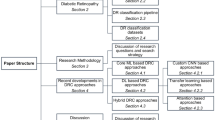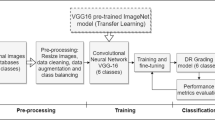Abstract
High glucose levels in the blood not only damage different tissues and organs of the body, but also cause adverse effects on the eye. This condition is called diabetic retinopathy (DR). DR can cause blurred vision, darkening of the field of vision, and severe vision loss. The number of people infected with the disease is increasing in our country and worldwide. The time-consuming physician check-ups and the presence of small lesions indicate the need to develop diagnostic systems. Deep learning-based applications have become the trend for diagnosing and grading diseases from images. This study aims to create a meaningful and sufficient dataset using effective data preprocessing and affine transformation techniques in diabetic retinopathy classification. In this study, classification was performed using seven different pre-trained deep learning architectures. An experimental study of each technique was performed on the EyePACS dataset. An overfitting problem was encountered in the experimental results with the original data set. Thus, data preprocessing and data augmentation processes were carried out in order to eliminate overfitting by considering the imbalance between classes in the dataset. The classification performance obtained from each architecture was observed according to performance metrics of precision, recall, F1 Score, accuracy, and loss. In this study, the best performance was achieved with 97.65% test accuracy with the proposed EfficientNetV2-M network model.










Similar content being viewed by others
Data Availability
Data sharing not applicable to this article as no datasets were generated or analyzed during the current study.
References
Abbood SH, Hamed HNA, Rahim MSM, Rehman A, Saba T, Bahaj SA (2022) Hybrid Retinal Image Enhancement Algorithm for Diabetic Retinopathy Diagnostic Using Deep Learning Model. IEEE 73079–73086. https://doi.org/10.1109/ACCESS.2022.3189374
AĞCA K, TAKCI H (2022) Hibrit Bir Model Oluşturarak Diyabetik Retinopati Sınıflandırılması. Avrupa Bilim ve Teknoloji Dergisi (36):227-236. https://doi.org/10.31590/ejosat.1112980
Al-Antary MT, Arafa Y (2021) Multi-scale attention network for diabetic retinopathy classification. IEEE Access 9:54190–54200. https://doi.org/10.1109/ACCESS.2021.3070685
APTOS Blindness Detection (2019) https://www.kaggle.com/competitions/aptos2019-blindness-detection/data. Accessed 12 Feb 2023
Berbar MA (2022) Features extraction using encoded local binary pattern for detection and grading diabetic retinopathy. Health Information Science and Systems 10(1):1–13. https://doi.org/10.1007/s13755-022-00181-z
Bilal A, Sun G, Mazhar S, Imran A, Latif J (2022) A Transfer Learning and U-Net-based automatic detection of diabetic retinopathy from fundus images. Computer Methods in Biomechanics and Biomedical Engineering: Imaging & Visualization 1–12. https://doi.org/10.1080/21681163.2021.2021111
Bilal A, Zhu L, Deng A, Lu H, Wu N (2022) AI-Based Automatic Detection and Classification of Diabetic Retinopathy Using U-Net and Deep Learning. Symmetry 14(7):1427. https://doi.org/10.3390/sym14071427
BİNGOL H (2022) Derin Öğrenme Modellerinde Komşuluk Bileşen Analizi Yöntemi Kullanarak Çiçek Görüntülerinin Sınıflandırılması. Fırat Üniversitesi Mühendislik Bilimleri Dergisi 34(1):439-447. https://doi.org/10.35234/fumbd.1053501
Chetoui M, Akhloufi MA (2020) Explainable end-to-end deep learning for diabetic retinopathy detection across multiple datasets. J Medical Imaging 7(4):044503. https://doi.org/10.1117/1.JMI.7.4.044503
Chetoui M, Akhloufi MA (2020) Explainable diabetic retinopathy using EfficientNET. In 2020 42nd annual international conference of the IEEE engineering in Medicine & Biology Society (EMBC). IEEE pp 1966-1969. https://doi.org/10.1109/EMBC44109.2020.9175664
Deore SP (2022) HDWR SmartNet: a smart handwritten Devanagari word recognition system using deep ResNet-based on scan profile method. In Data Science. Chapman and Hall/CRC. pp 57-77
García G, Gallardo J, Mauricio A, López J, Carpio CD (2017) Detection of diabetic retinopathy based on a convolutional neural network using retinal fundus images. In International Conference on Artificial Neural Networks. Springer, Cham, pp 635-642 https://doi.org/10.1007/978-3-319-68612-7
Garner A (1993) Histopathology of diabetic retinopathy in man. Eye 7(2):250–253. https://doi.org/10.1038/eye.1993.58
Hastuti ET, Bustamam A, Anki P, Amalia R, Salma A (2021) Performance of True Transfer Learning using CNN DenseNet121 for COVID-19 Detection from Chest X-Ray Images. In 2021 IEEE International Conference on Health, Instrumentation & Measurement, and Natural Sciences (InHeNce). IEEE pp 1-5 https://doi.org/10.1109/InHeNce52833.2021.9537261
He K, Zhang X, Ren S, Sun J (2016) Deep residual learning for image recognition. In Proc IEEE Conf Comput Vis Pattern Recognit pp 770-778
Introduction to VGG16 | What is VGG16? https://www.mygreatlearning.com/blog/introduction-to-vgg16. Accessed 26 Sept 2022
Jabbar MK, Yan J, Xu H, Ur Rehman Z, Jabbar A (2022) Transfer Learning-Based Model for Diabetic Retinopathy Diagnosis Using Retinal Images. Brain Sciences 12(5):535. https://doi.org/10.3390/brainsci12050535
Kaggle EyePACS dataset (2022) https://www.kaggle.com/datasets/tanlikesmath/diabetic-retinopathy-resized. Accessed 26 June 2022
Kajan S, Goga J, Lacko K, Pavlovičová J (2020) Detection of diabetic retinopathy using pretrained deep neural networks. In 2020 Cybernetics & Informatics (K &I). IEEE pp 1-5. https://doi.org/10.1109/KI48306.2020.9039793
Khade AA, Vidhate AV (2022) Application of Artificial Intelligence Techniques in the Early-Stage Detection of Chronic Kidney Disease. In Data Science. Chapman and Hall/CRC. pp 119-129
Kumar R, Singh D, Chug A, Singh AP (2022) Evaluation of Deep learning based Resnet-50 for Plant Disease Classification with Stability Analysis. In 2022 6th International Conference on Intelligent Computing and Control Systems (ICICCS). IEEE pp 1280-1287. https://doi.org/10.1109/ICICCS53718.2022.9788207
Lal S, Rehman SU, Shah JH, Meraj T, Rauf HT, Damaševičius R, Mohammed MA, Abdulkareem KH (2021) Adversarial attack and defence through adversarial training and feature fusion for diabetic retinopathy recognition. Sensors 21(11):3922. https://doi.org/10.3390/s21113922
Leeza M, Farooq H (2019) Detection of severity level of diabetic retinopathy using Bag of features model. IET Computer Vision 13(5):523–530. https://doi.org/10.1049/iet-cvi.2018.5263
Li B, Lima D (2021) Facial expression recognition via ResNet-50. Int J Cogn Comput Eng 2:57–64. https://doi.org/10.1016/j.ijcce.2021.02.002
Li X, Shen X, Zhou Y, Wang X, Li TQ (2020) Classification of breast cancer histopathological images using interleaved DenseNet with SENet (IDSNet). PloS one 15(5):e0232127. https://doi.org/10.1371/journal.pone.0232127
Li Y, Song Z, Kang S, Jung S, Kang W (2021) Semi-supervised auto-encoder graph network for diabetic retinopathy grading. IEEE Access 9:140759–140767. https://doi.org/10.1109/ACCESS.2021.3119434
Li C, Zhao W, Meng L, Chen Z, Zhao Y, Cao Z (2022) Fungi Recognition Based on Coordinate Attention and EfficientNetV2. In 2022 5th International Conference on Artificial Intelligence and Big Data (ICAIBD). IEEE pp 427-432. https://doi.org/10.1109/ICAIBD55127.2022.9820024
Malve P, Gulhane VS (2022) Multi-Optimal Deep Learning Technique for Detection and Classification of Breast Cancer. In Data Science. Chapman and Hall/CRC. pp 131-142
Maqsood S, Damaševičius R, Maskeliūnas R (2021) Hemorrhage detection based on 3D CNN deep learning framework and feature fusion for evaluating retinal abnormality in diabetic patients. Sensors 21(11):3865. https://doi.org/10.3390/s21113865
Masood S, Luthra T, Sundriyal H, Ahmed M (2017) Identification of diabetic retinopathy in eye images using transfer learning. In 2017 International Conference on Computing, Communication and Automation (ICCCA). IEEE pp 1183-1187 https://doi.org/10.1109/CCAA.2017.8229977
Nirthika R, Manivannan S, Ramanan A (2022) Siamese network based fine grained classification for Diabetic Retinopathy grading. Biomedical Signal Processing and Control 78:103874. https://doi.org/10.1016/j.bspc.2022.103874
Omar K, ElSahhar M, El-Dine MA, Talaat Y, Hassan YM, Hamdy A (2021) Automatic Classification of Preliminary Diabetic Retinopathy Stages using CNN. Int J Adv Comput Sci Appl 12(2)
Özbay E (2022) An active deep learning method for diabetic retinopathy detection in segmented fundus images using artificial bee colony algorithm. Artif Intell Rev 1–28. https://doi.org/10.1007/s10462-022-10231-3
Park J, Oh S, Jeong J (2022) A Defect Detection Model for Casting Product using Wavelet Transform Denoise and Xception. In 2022 24th International Conference on Advanced Communication Technology (ICACT). IEEE pp 247-251. https://doi.org/10.23919/ICACT53585.2022.9728921
Qureshi I, Ma J, Abbas Q (2021) Diabetic retinopathy detection and stage classification in eye fundus images using active deep learning. Multimedia Tools Appl 80(8):11691–11721. https://doi.org/10.1007/s11042-020-10238-4
Ramasamy LK, Padinjappurathu SG, Kadry S, Damaševičius R (2021) Detection of diabetic retinopathy using a fusion of textural and ridgelet features of retinal images and sequential minimal optimization classifier. PeerJ Comput Sci 7:e456. https://doi.org/10.7717/peerj-cs.456
Reguant R, Brunak S, Saha S (2021) Understanding inherent image features in CNN-based assessment of diabetic retinopathy. Scientific Reports 11(1):1–12. https://doi.org/10.1038/s41598-021-89225-0
Sakhare P, Chavan PV, Kulkarni P, Sarode A (2022) Instigation and Development of Data Science. In Data Science. Chapman and Hall/CRC. pp 1-19
Saraf V, Chavan P, Jadhav A (2020) Deep learning challenges in medical imaging. In Advanced Computing Technologies and Applications: Proceedings of 2nd International Conference on Advanced Computing Technologies and Applications-ICACTA 2020. Springer, Singapore, pp 293-301. https://doi.org/10.1007/978-981-15-3242-9_28
Shah A, Chavan P, Jadhav D (2022) Convolutional Neural Network-Based Image Segmentation Techniques. In Soft Computing and Signal Processing: Proceedings of 3rd ICSCSP 2020 Volume 2. Springer, Singapore, pp 553-561. https://doi.org/10.1007/978-981-16-1249-7_52
Shetgaonkar P, Aswale S, Naik S, Gaonkar A, Gawade S, Mhalsekar P (2021) Diabetic Retinopathy Detection and Classification from Fundus Images Using Deep Learning. In 2021 International Conference on Technological Advancements and Innovations (ICTAI). IEEE pp 133-139 https://doi.org/10.1109/ICTAI53825.2021.9673345
Szegedy C, Liu W, Jia Y, Sermanet P, Reed S, Anguelov D, Rabinovich A (2015). Going deeper with convolutions. In Proc IEEE Conf Comput Vis Pattern Recognit pp 1-9. https://doi.org/10.1109/CVPR.2015.7298594
Szegedy C, Vanhoucke V, Ioffe S, Shlens J, Wojna Z (2016) Rethinking the inception architecture for computer vision. In Proc IEEE Conf Comput Vis Pattern Recognit pp 2818-2826
Tan M, Le Q (2021) Efficientnetv2: Smaller models and faster training. In International Conference on Machine Learning pp 10096-10106. PMLR
Taufiqurrahman S, Handayani A, Hermanto BR, Mengko, TLER (2020) Diabetic retinopathy classification using a hybrid and efficient MobileNetV2-SVM model. In 2020 IEEE REGION 10 CONFERENCE (TENCON). IEEE pp 235-240. https://doi.org/10.1109/TENCON50793.2020.9293739
Theckedath D, Sedamkar RR (2020) Detecting affect states using VGG16, ResNet50 and SE-ResNet50 networks. SN Comput Sci 1(2):1–7. https://doi.org/10.1007/s42979-020-0114-9
Thorat S, Chavan A, Sawant P, Kulkarni S, Sisodiya N, Kolapkar A (2021) Diabetic Retinopathy Detection by means of Deep Learning. In 2021 5th International Conference on Intelligent Computing and Control Systems (ICICCS). IEEE pp 996-999. https://doi.org/10.1109/ICICCS51141.2021.9432075
Wan S, Liang Y, Zhang Y (2018) Deep convolutional neural networks for diabetic retinopathy detection by image classification. Comput Electr Eng 72:274–282. https://doi.org/10.1016/j.compeleceng.2018.07.042
What is diabetes (2022) International diabetes federation. https://www.idf.org/aboutdiabetes/what-is-diabetes.html. Accessed 26 June 2022
What is diabetic retinopathy (2022) American academy of ophthalmology. https://www.aao.org/eye-health/diseases/what-is-diabetic-retinopathy. Accessed 26 June 2022
Wilkinson CP, Ferris FL III, Klein RE, Lee PP, Agardh CD, Davis M et al (2003) Proposed international clinical diabetic retinopathy and diabetic macular edema disease severity scales. Ophthalmology 110(9):1677–1682. https://doi.org/10.1016/S0161-6420(03)00475-5
Yaqoob MK, Ali SF, Kareem I, Fraz MM (2020) Feature-based optimized deep residual network architecture for diabetic retinopathy detection. In 2020 IEEE 23rd International Multitopic Conference (INMIC). IEEE pp 1-6. https://doi.org/10.1109/INMIC50486.2020.9318096
Yaqoob MK, Ali SF, Bilal M, Hanif MS, Al-Saggaf UM (2021) ResNet based deep features and random forest classifier for diabetic retinopathy detection. Sensors 21(11):3883. https://doi.org/10.3390/s21113883
Yu M, Wang Y (2022) Intelligent detection and applied research on diabetic retinopathy based on the residual attention network. Int J Imaging Syst Technol. https://doi.org/10.1002/ima.22734
Zhang C, Lei T, Chen P (2022) Diabetic retinopathy grading by a source-free transfer learning approach. Biomed Signal Process Control 73:103423. https://doi.org/10.1016/j.bspc.2021.103423
Author information
Authors and Affiliations
Corresponding author
Ethics declarations
Conflicts of interest
The authors has declared that no conflict of interests or competing interests exist.
Additional information
Publisher's Note
Springer Nature remains neutral with regard to jurisdictional claims in published maps and institutional affiliations.
Rights and permissions
Springer Nature or its licensor (e.g. a society or other partner) holds exclusive rights to this article under a publishing agreement with the author(s) or other rightsholder(s); author self-archiving of the accepted manuscript version of this article is solely governed by the terms of such publishing agreement and applicable law.
About this article
Cite this article
İncir, R., Bozkurt, F. A study on effective data preprocessing and augmentation method in diabetic retinopathy classification using pre-trained deep learning approaches. Multimed Tools Appl 83, 12185–12208 (2024). https://doi.org/10.1007/s11042-023-15754-7
Received:
Revised:
Accepted:
Published:
Issue Date:
DOI: https://doi.org/10.1007/s11042-023-15754-7




